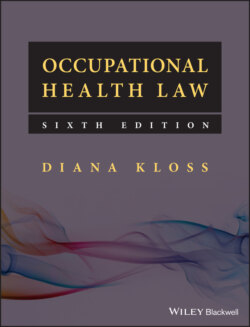Читать книгу Occupational Health Law - Diana Kloss - Страница 41
1.8 The relationship between the occupational health service and the general practitioner
ОглавлениеThe preventive aspects of the OH specialists need not impinge on the general practitioner’s function. If the worker is found to be suffering from some work‐related illness, or has an accident at work, the GP should be informed, if the patient gives consent. Treatment is more problematic. The Faculty of Occupational Medicine advises that the occupational physician should treat a patient only in co‐operation with the patient’s GP except in an emergency. If he thinks that the worker should consult his GP, he should urge him to do so. The occupational physician should refer a patient directly to hospital only in consultation or in agreement with the GP. He should not influence or appear to influence any worker in his choice of GP. The RCN advises OH nurses not to undertake specific treatments without the request of the GP in writing, other than treatment for minor injuries and in an emergency. Vaccination and immunisation programmes for workers at risk must be supervised by a registered medical practitioner.
An area of potential conflict is the confirmation that absence from work is due to sickness so that the worker can claim sick leave and sick pay from his employer. This is usually the GP’s job and he is only obliged by his contract to give a fit note free of charge after seven days’ absence. However, the employer may ask the OH department for their advice as to the fitness of the worker. The employer’s motive may be suspicion that the employee is malingering. Frequent or lengthy absence may indicate a serious health problem which may put other workers at risk. The worker’s absence may be causing the employer financial problems and other employees may be showing resentment. The BMA advises consultation with the GP (with the employee’s consent). If the GP and the OH doctor disagree, and there is the prospect of disciplinary action, the employer may allow the employee within company procedures the right to go ‘on appeal’ to an independent consultant, or the employer may decide to prefer OH advice on the ground that OH knows the work as well as the worker (Chapter 7).
Where the occupational physician is also the worker’s general practitioner (a not uncommon event), the physician must be careful to keep the two functions separate. In such cases, it might be preferable to encourage the patient to see another doctor in the practice (if there is one) or even to register with a different GP. Information about the employee must not be transferred from the OH to the GP records, or vice versa, without the employee’s consent.
In addition, wherever possible, a doctor should avoid acting as an occupational health adviser to an individual where another relationship exists, eg as manager, departmental colleague or primary care physician. If this is unavoidable, particular care should be taken to ensure that the patient understands the context of the consultation and agrees to its terms
(Good Occupational Medical Practice).
